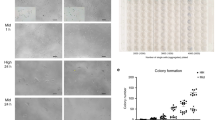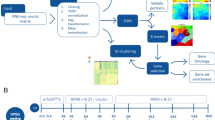Abstract
Human embryonic stem (hES) cells hold promise for generating an unlimited supply of cells for replacement therapies. To characterize hES cells at the molecular level, we obtained 148,453 expressed sequence tags (ESTs) from undifferentiated hES cells and three differentiated derivative subpopulations. Over 32,000 different transcripts expressed in hES cells were identified, of which more than 16,000 do not match closely any gene in the UniGene public database. Queries to this EST database revealed 532 significantly upregulated and 140 significantly downregulated genes in undifferentiated hES cells. These data highlight changes in the transcriptional network that occur when hES cells differentiate. Among the differentially regulated genes are several components of signaling pathways and transcriptional regulators that likely play key roles in hES cell growth and differentiation. The genomic data presented here may facilitate the derivation of clinically useful cell types from hES cells.
This is a preview of subscription content, access via your institution
Access options
Subscribe to this journal
Receive 12 print issues and online access
$209.00 per year
only $17.42 per issue
Buy this article
- Purchase on Springer Link
- Instant access to full article PDF
Prices may be subject to local taxes which are calculated during checkout




Similar content being viewed by others
References
Reubinoff, B., Pera, M.F., Fong, C.-Y., Trounson, A. & Bongso, A. Embryonic stem cell lines from human blastocysts: somatic differentiation in vitro. Nat. Biotechnol. 18, 399–404 (2000).
Thomson, J.A. et al. Embryonic stem cell lines derived from human blastocysts. Science 282, 1145–1147 (1998).
Xu, C. et al. Feeder-free growth of undifferentiated human embryonic stem cells on defined matrices with conditioned medium. Nat. Biotechnol. 19, 971–974 (2001).
Rambhatla, L., Chiu, C.P., Kundu, P., Peng, Y. & Carpenter, M.K. Generation of hepatocyte-like cells from human embryonic stem cells. Cell Transplant. 12, 1–11 (2003).
Carpenter, M.K. et al. Enrichment of neurons and neural precursors from human embryonic stem cells. Exp. Neurol. 172, 383–397 (2001).
Lebkowski, J.S. et al. Human embryonic stem cells: culture, differentiation, and genetic modification for regenerative medicine applications. Cancer J. 7 (Suppl.), S83–S93 (2001).
Schuler, G.D. et al. A gene map of the human genome. Science 274, 540–546 (1996).
Boguski, M.S., Lowe, T.M. & Tolstoshev, C.M. dbEST–database for “expressed sequence tags.” Nat. Genet. 4, 332–333 (1993).
Okubo, K. et al. Large scale cDNA sequencing for analysis of quantitative and qualitative aspects of gene expression. Nat. Genet. 2, 173–179 (1992).
Siegel, S. & Castellan, N. Nonparametric Statistics for the Behavioral Sciences edn. 2 (McGraw-Hill, London, 1988).
Yoshida, K. et al. Maintenance of the pluripotential phenotype of embryonic stem cells through direct activation of gp130 signalling pathways. Mech. Dev. 45, 163–171 (1994).
Schuringa, J.J. van der Schaaf, S., Vellenga, E., Eggen, B.J. & Kruijer, W. LIF-induced STAT3 signaling in murine versus human embryonal carcinoma (EC) cells. Exp. Cell Res. 274, 119–129 (2002).
Metcalf, D. The unsolved enigmas of leukemia inhibitory factor. Stem Cells 21, 5–14 (2003).
Bravo, J. & Heath, J.K. Receptor recognition by gp130 cytokines. EMBO J. 19, 2399–2411 (2000).
Aaronson, D.S. & Horvath, C.M. A road map for those who know JAK-STAT. Science 296, 1653–1655 (2002).
Schindler, C.W. Series introduction. JAK-STAT signaling in human disease. J. Clin. Invest. 109, 1133–1137 (2002).
Duval, D., Reinhardt, B., Kedinger, C. & Boeuf, H. Role of suppressors of cytokine signaling (Socs) in leukemia inhibitory factor (LIF)-dependent embryonic stem cell survival. FASEB J. 14, 1577–1584 (2000).
Carpenter, M.K. et al. Properties of four human embryonic stem cell lines maintained in a feeder-free culture system. Dev. Dyn. 229, 243–258 (2004).
Ornitz, D.M. & Itoh, N. Fibroblast growth factors. Genome Biol. 2, R3005 (2001).
Ornitz, D.M. et al. Receptor specificity of the fibroblast growth factor family. J. Biol. Chem. 271, 15292–15297 (1996).
Goldfarb, M. Signaling by fibroblast growth factors: the inside story. Science STKE 2001, PE37 (2001).
Taipale, J. & Beachy, P.A. The Hedgehog and Wnt signalling pathways in cancer. Nature 411, 349–354 (2001).
Reya, T. et al. A role for Wnt signalling in self-renewal of haematopoietic stem cells. Nature 423, 409–414 (2003).
Willert, K. et al. Wnt proteins are lipid-modified and can act as stem cell growth factors. Nature 423, 448–452 (2003).
Tang, K. et al. Wnt-1 promotes neuronal differentiation and inhibits gliogenesis in P19 cells. Biochem. Biophys. Res. Commun. 293, 167–173 (2002).
Aubert, J., Dunstan, H., Chambers, I. & Smith, A. Functional gene screening in embryonic stem cells implicates Wnt antagonism in neural differentiation. Nat. Biotechnol. 20, 1240–1245 (2002).
Ding, S. et al. Synthetic small molecules that control stem cell fate. Proc. Natl. Acad. Sci. USA 100, 7632–7637 (2003).
Gregory, C.A., Singh, H., Perry, A.S. & Prockop, D.J. The Wnt signaling inhibitor dick-kopf-1 is required for reentry into the cell cycle of human adult stem cells from bone marrow. J. Biol. Chem. 278, 28067–28078 (2003).
Li, X., Yost, H.J., Virshup, D.M. & Seeling, J.M. Protein phosphatase 2A and its B56 regulatory subunit inhibit Wnt signaling in Xenopus. EMBO J. 20, 4122–4131 (2001).
Schier, A.F. & Shen, M.M. Nodal signalling in vertebrate development. Nature 403, 385–389 (2000).
Purandare, S.M. et al. A complex syndrome of left-right axis, central nervous system and axial skeleton defects in Zic3 mutant mice. Development 129, 2293–2302 (2002).
Gebbia, M. et al. X-linked situs abnormalities result from mutations in ZIC3. Nat. Genet. 17, 305–308 (1997).
Cavaleri, F. & Scholer, H.R. Nanog. A new recruit to the embryonic stem cell orchestra. Cell 113, 551–552 (2003).
Botquin, V. et al. New POU dimer configuration mediates antagonistic control of an osteopontin preimplantation enhancer by Oct-4 and Sox-2. Genes Dev. 12, 2073–2090 (1998).
Yuan, H., Corbi, N., Basilico, C. & Dailey, L. Developmental-specific activity of the FGF-4 enhancer requires the synergistic action of Sox2 and Oct-3. Genes Dev. 9, 2635–2645 (1995).
Schoorlemmer, J. et al. Characterization of a negative retinoic acid response element in the murine Oct4 promoter. Mol. Cell. Biol. 14, 1122–1136 (1994).
Ben-Shushan, E., Sharir, H., Pikarsky, E. & Bergman, Y. A dynamic balance between ARP-1/COUP-TFII, EAR-3/COUP-TFI, and retinoic acid receptor:retinoid X receptor heterodimers regulates Oct-3/4 expression in embryonal carcinoma cells. Mol. Cell. Biol. 15, 1034–1048 (1995).
Audic, S. & Claverie, J.M. The significance of digital gene expression profiles. Genome Res. 7, 986–995 (1997).
Ewing, R.M. et al. Large-scale statistical analyses of rice ESTs reveal correlated patterns of gene expression. Genome Res. 9, 950–959 (1999).
Claverie, J.M. Computational methods for the identification of differential and coordinated gene expression. Hum. Mol. Genet. 8, 1821–1832 (1999).
Ko, M.S. et al. Large-scale cDNA analysis reveals phased gene expression patterns during preimplantation mouse development. Development 127, 1737–1749 (2000).
Strausberg, R.L., Dahl, C.A. & Klausner, R.D. New opportunities for uncovering the molecular basis of cancer. Nat. Genet. 15 (Suppl.), 415–416 (1997).
Rohlf, F.K., Sokal, R.R. & Freeman, W.H. Statistical Tables, Edn. 3. (WH Freeman & Co., New York; 1994).
Ramalho-Santos, M., Yoon, S., Matsuzaki, Y., Mulligan, R.C. & Melton, D.A. “Stemness”: transcriptional profiling of embryonic and adult stem cells. Science 298, 597–600 (2002).
Ivanova, N.B. et al. A stem cell molecular signature. Science 298, 601–604 (2002).
Adams, M.D. et al. Sequence identification of 2,375 human brain genes. Nature 355, 632–634 (1992).
Smith, T.P., Godtel, R.A. & Lee, R.T. PCR-based setup for high-throughput cDNA library sequencing on the ABI 3700 automated DNA sequencer. Biotechniques 29, 698–700 (2000).
Pop, M. & Kosack, D. Using the TIGR assembler in shotgun sequencing projects. Methods Mol. Biol. 255, 279–294 (2004).
Altschul, S.F. et al. Gapped BLAST and PSI-BLAST: a new generation of protein database search programs. Nucleic Acids Res. 25, 3389–3402 (1997).
Acknowledgements
We thank Ellen Beasley, Melissa Carpenter, Dennis Gilbert, Joseph D. Gold, Calvin Harley, Greg Fisk, Gregg Morin and Catherine Priest for valuable discussions and Michael G. Walker for help with the statistical analysis. We acknowledge Jakyoung Agnew, Jerrod Denham, Kathaleen Golds, Robert Holt, Margaret Inokuma, Karen Ketchum, Michael Mok, Steven Rabkin and Tim Stockwell for expert technical assistance.
Author information
Authors and Affiliations
Corresponding author
Ethics declarations
Competing interests
Several of the authors are or were employees of Geron Corporation or Celera Genomics.
Rights and permissions
About this article
Cite this article
Brandenberger, R., Wei, H., Zhang, S. et al. Transcriptome characterization elucidates signaling networks that control human ES cell growth and differentiation. Nat Biotechnol 22, 707–716 (2004). https://doi.org/10.1038/nbt971
Received:
Accepted:
Published:
Issue Date:
DOI: https://doi.org/10.1038/nbt971
This article is cited by
-
The transcription factor Zfp281 sustains CD4+ T lymphocyte activation through directly repressing Ctla-4 transcription
Cellular & Molecular Immunology (2020)
-
The Fuchs corneal dystrophy-associated CTG repeat expansion in the TCF4 gene affects transcription from its alternative promoters
Scientific Reports (2020)
-
Identification of key genes and construction of microRNA–mRNA regulatory networks in bladder smooth muscle cell response to mechanical stimuli using microarray expression profiles and bioinformatics analysis
World Journal of Urology (2018)
-
Trib2 regulates the pluripotency of embryonic stem cells and enhances reprogramming efficiency
Experimental & Molecular Medicine (2017)
-
ZNF281 Promotes Growth and Invasion of Pancreatic Cancer Cells by Activating Wnt/β-Catenin Signaling
Digestive Diseases and Sciences (2017)



